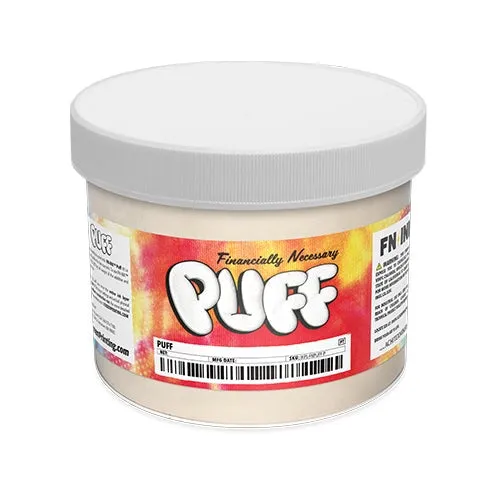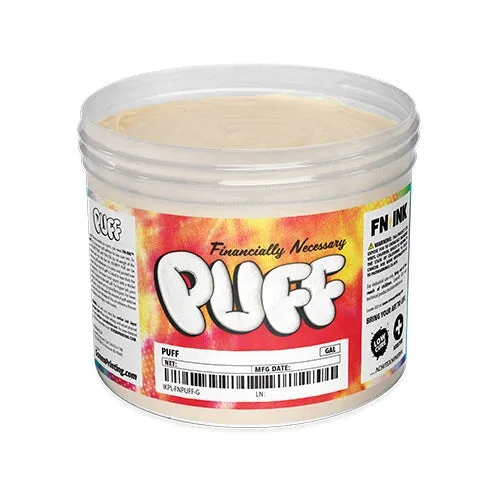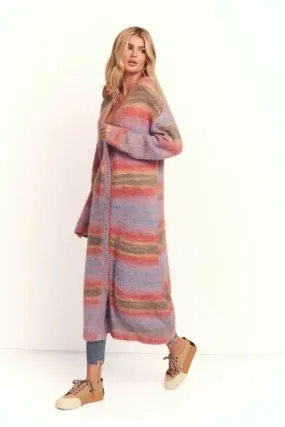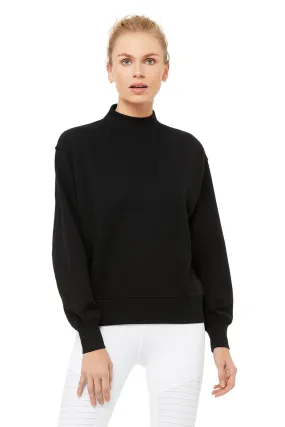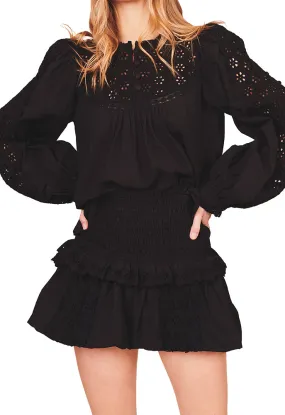Add dimensionality to a print with FN-INK™ Puff. It can be mixed in a base white or mixed with colors and printed over a base.
FN-INK™ Puff is a low cure puff additive meant to be used in low cure inks and cured at lower temperatures. When printed and cured correctly, the ink will have dimensionality (puff). FN-INK™ Puff can be used at 10%–20% by the ink’s weight and printed as either a puff underbase, in colors printed directly to the shirt fabric, or in a low cure ink printing over an underbase.
When printing inks mixed with FN-INK™ Puff, the amount of ink loft (puff) is directly proportional to how thick the ink deposit is. It is recommended to use lower mesh counts like a 110 (up to 157 thin thread) with a slightly thicker stencil to create the desired puff. A thin ink deposit will puff slightly while a thick ink deposit will puff a lot.
If you want a higher amount of puff, print a thicker ink deposit or try a print-flash-print.
If you need a lower puff response, either lower the amount of puff additive or print a thinner ink deposit. Achieve a thinner ink deposit with higher mesh counts.
Bring your art to life. Unlock specialty printing with FN-INK™ Puff.
HOW DOES A PUFF ADDITIVE WORK?
A puff additive is made of tiny spherules that expand when they reach a specific temperature. When the spherules expand, the ink raises or puffs. FN-INK™ Puff will activate at about 200°F with complete puff being achieved at full cure.
FEATURES
- Adds loft or creates 3D effect
- Easy to work with
- Lower cure temperatures
BENEFITS
- Causes a print to puff or create a 3D effect, a unique technique that can expand a printer's services.
- Its low cure property speeds up production while decreasing electrical costs.
- Printers can add it to a white to print it as a puff underbased or mix it with low cure ink colors, giving them options to find the best method for each unique job.
RECOMMENDATION FOR USE
Mix at a ratio of 10% to 20% by weight into a low cure ink. Mix thoroughly. If adding more than 20%, do thorough cure and wash testing to ensure wash fastness. Additions above 20% may result in the ink becoming unstable and flaky, especially after it’s washed.
Always test before running production. Print recommendations below.
SCREEN MESH
Use lower mesh counts like 86-110 mesh, or a 157 thin thread, with a slightly thicker stencil. How much an ink layer puffs depends on the thickness of the ink deposit. It’s important to use the right mesh to achieve a thicker ink deposit. Higher tension screens are strongly recommended.
STENCIL & EMULSION GUIDELINES
Any emulsion works with FN-INK™ Puff. However, using a is recommended as it will create a thicker stencil with fewer coat applications. You’ll know when you’ve achieved a thicker stencil when you can run your finger over the edge of the stencil and clearly feel the edge of the emulsion.
86-110 standard mesh can be used. If you’re using thin thread mesh, select a screen with 110-157 mesh count.
MIXING
Be sure to stir the product prior to use. Add at a ratio of 10%-20% by weight to low cure plastisol ink. Stir thoroughly. You can add more or less of the puff additive depending on the desired outcome. Adding more than 20% can lead to the ink puffing too much and not having enough strength to remain stable when laundered. Always print and perform a wash test before production.
PRINTING & FLASHING
When setting up the screen, slightly increase the off-contact than you normally would. The purpose is to compensate for the thicker stencil and ink deposit.
Use a softer squeegee like a 60 or 65/90/65 durometer. A softer squeegee will help with laying down a thicker ink layer. A 70 durometer blade can also be used. Using a squeegee with a stiffer or harder blade will result in a thinner ink deposit; therefore, less puff.
When possible, do a flood print. The flood stroke will pre-fill the thicker stencil and make it easier to fully clear the ink from the screen. You’ll have a smoother ink deposit.
It is recommended to do two passes with the squeegee. It’ll ensure a thick ink deposit.
If flashing is needed, be careful because too much heat will cause the ink to puff prematurely. If ink puffs too early, it can lead to over-curing and the puff will collapse. Raise your flash if necessary to make the heating of the puff ink more consistent. More details below.
PRINTING OVER AN UNDERBASE
You can print any puff ink over another ink, like a white underbase. The ink will not visually puff as much as ink printed directly on the shirt. Puff ink printed directly to fabric will cause the shirt to pucker, which increases the visibility of the puff.
If choosing to print on top of an underbase, test vigorously and create shop standards for all designs and screen/stencil making.
Take care during the curing process. The puff ink will activate and begin to puff before the underbase reaches full cure. You will want to run the conveyor dryer slower and at a lower temperature to ensure a slower, deeper penetration of heat. Do not run the dryer hot and fast. As always, test before running production.
CURING
Since FN-INK™ Puff is a low cure additive, the ink deposit cannot get too hot. The puff will fully activate when the ink reaches temperatures of 260°F. When properly cured, the ink is wash-stable. The puff additive is temperature-stable to around 290°F. If the ink gets hotter than those temperatures, the puff ink will begin to collapse.
TESTING & PRECAUTIONS
To test if the print is correctly cured, perform a wash test. You may also run a light abrasion test to watch for flaking and test adhesion (but a wash test will always provide the most accurate results). Perform all testing before going into production.
CLEAN UP
Use any to clean it up.
SHELF LIFE & STORAGE
Keep container(s) tightly closed. Store in a cool, well-ventilated location out of direct sunlight.
FN-INK™ Puff has approximately a two-year shelf life.




